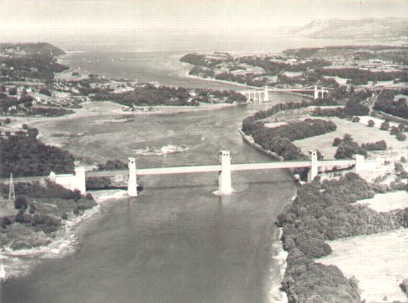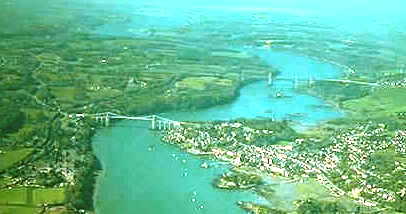But the reversal of the stream doesn't coincide with level parity. Instead the inertia of the existent stream causes it to continue flowing for a while ('uphill' as it were) until it all comes rushing back again much like sluicing water back and forth by up-ending a bathtub. Thus unlike conventional tides, where the beginnings of the new stream are barely perceptable and only very gradually become apparent, on a big tide in the Menai Strait the onset of 'The Ebb' is unusually marked, and gathers momentum very rapidly. Not only is the new stream reinforced by the carry-over beyond level parity from the other, but being delayed beyond level parity, by the time 'The Ebb' sets in on a big tide there is already an appreciable difference in water levels. The combined effect can sometimes be quite dramatic. I remember several occasions sitting out on the port chains on summer evenings at the Plas Newydd mooring, when the silence of the evening was suddenly shattered by a single swiftly moving wave travelling against the direction of flow, which went unnoticed in deep water, but which fizzed and cracked sharply as it exploded its energy noisily along the shallows of the Caernarvonshire shore, leading to much fanciful speculation as to what this sinister, sudden intruder might mean. (was it the wash of a ghost ship etc.?) Looking back on it a lifetime later and what we had witnessed was of course a Tidal Bore.
A Tidal Bore is formed when the tide rises at such a rate that it forces the tidal wave front to move at a faster speed than a shallow water wave is able to at that depth of water. This causes a shock wave to be formed, the visible evidence of which is a wall of water back-tracking against the direction of flow. Nowhere have I ever seen any refernce to a Tidal Bore in the Menai Strait, but I've no hesitation in stating that there is one because I've seen it myself on several occasions. Not that it's a very big one, and likely only occurs on the highest tides. By contrast the Tidal Bore in the Amazon (for example) can attain a height of 5 meters and travel inland for up to 80 km. (For more information about, and photographs of Tidal Bores look at:- and look about a quarter way down the introductory page at 'Surges and Tidal Bores'. See also


Fig.5: The Swellies : Looking southwest, with Plas Newydd just discernible in line with the southern pillar of Britannia Bridge.
The Southwest Residual. In addition to the tide generated streams in the Menai Strait there is also a non-tidal current, which is referred to quite simply as the 'Southwest Residual', and is thought to be a dynamic reaction to the energy expended by the tide upon the restrictive environment of the Strait and the consequent difference in tidal range at its ends. For a full understanding of the Residual please read : The Flow of Water through the Menai Strait by Prof J.G. Harvey, and Electromagnetic Observations of Water Flow in the Menai Strait by Prof J.H. Simpson. Those aboard Conway during spring term 1968 will remeber this latter, since it was Conway's boats which laid and recovered Simpson's equipment.
Although not invariably so, the Residual is dominantly southwestward,(Harvey p520 line 19) and explains why the southwest-going stream is typically stronger than, and normally lasts for longer than the northeast-going